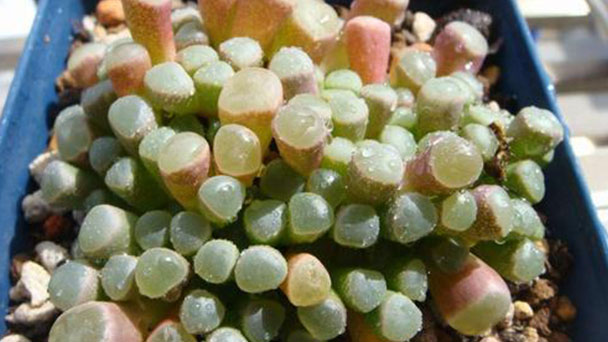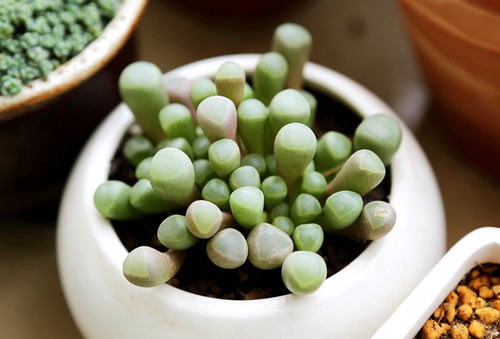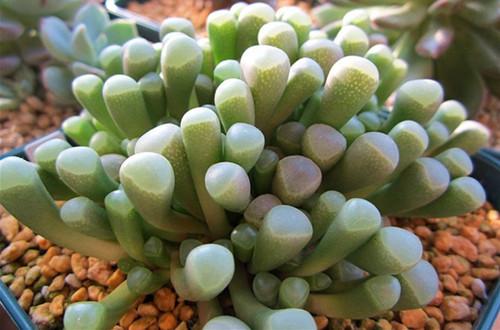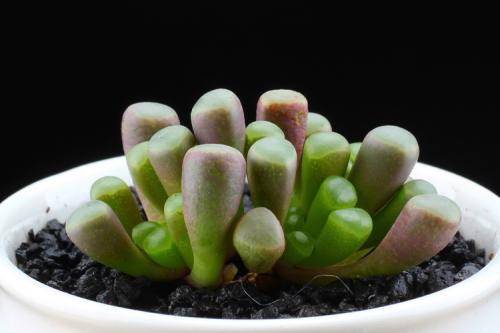Fenestraria Rhopalophylla profile
Written by Maggie
Dec 02 2020

Fenestraria Rhopalophylla is found in coastal areas of southern Africa and cultivated in many parts of the world. It prefers warm, dry, sunny environments, avoiding water wet, dark. It requires non - fertilizer, loose, grain more sandy loam.Hibernate in summer and bloom in winter. It is a popular ornamental flower with peculiar rod-shaped leaves, compact plants and bright flowers, and is often used to make exquisite bonsai, bottle and frame scenes.
Fenestraria Rhopalophylla picture

Fenestraria Rhopalophylla morphological characteristics
Fenestraria Rhopalophylla is a succulent perennial herb, with dense clusters of plants. The plant height is 5 centimeters and the plant width is 30 centimeters. The stem is very short or stemless, lignified at the junction of root and leaf base.
Leaves are highly fleshy, opposite, 2-3 cm long, clavate, coarsely rounded apically, pale green to gray-green, base slightly reddish, upper part of leaves with minimal transparent spots and covered with a waxy protective layer. The tip of the leaf is transparent and slightly convex, called the "window", and is used to receive sunlight.
Flowers are large, orange-yellow to golden, 3-7 cm long, solitary or clustered, perianth 5 sepals, imbricate, petiole slender, 4-5 cm long. The capsule is fleshy. Seeds are very small. Flowering period is in August - December.
Fenestraria Rhopalophylla growth habits
Fenestraria Rhopalophylla enjoys warm, dry, sunny environments. It is resistant to high temperature and drought or semi-shade, not resistant to cold. It’s afraid of wet, dark and strong light exposure. The soil should be loose sandy loam with good drainage and large grain size. In summer or winter when the temperature is too high or low, it comes into dormancy. The suitable temperature for growth is 18℃-24℃, and the growth temperature in winter is not less than 12℃. In order to reduce water loss, the plants usually embed all the leaves in the soil, leaving only the top area exposed. Sunlight enters the window and enters the inside of the leaves for photosynthesis.
Fenestraria Rhopalophylla geographic distribution
Fenestraria Rhopalophylla is distributed in coastal areas of South Africa and In Cape Province, Namaqualand and Luderites of Namibia, especially in Cape Province.Cultivation occurs in many parts of the world.

Fenestraria Rhopalophylla breeding method
sow
Sowing in April and May in the spring, because fenestraria rhopalophylla seeds are small, indoor pot sowing is generally adopted. After sowing, the soil need not be covered, otherwise the seeds cannot germinate. When the soil is dry, soaking pot method should be adopted to water, do not directly water, so as not to lose the seeds. The sowing temperature is 15-25℃. After sowing, the seedlings germinate for about half a month. After emerging, the seedlings gradually see light. Seedlings are only the size of soybeans, and growth is slow, so management must be careful. Generally after growing, apply watering every 3-5 days. It takes two to three years for the seedlings to bloom.
Points of Fenestraria Rhopalophylla
Dig up and decompose densely clustered fenestraria Rhopalophylla plants and plant them again, taking care not to bury the leaves too deep.
Fenestraria Rhopalophylla main value
Fenestraria Rhopalophylla has a strange shape, is pearl-jade, rich luster. In Europe and The United States, people are used to calling it "baby toe", is one of the rare varieties of indoor potted plants.
This kind of flower is bigger, the color is bright and bright, it becomes a kind of popular and rare ornamental flower. It is often used alone, delicate little potted plants are planted, serve as a kind of adornment, and can be put at windowsill, desk, desk, rich ancient wear, very elegant and lovely. Fenestraria Rhopalophylla can also be used to configure bottle view and frame view.

Latest Updated
- Benefits of Bugleweed - 7 Science-backed Health Benefits
- Bugleweed Dangers & Side Effects - Is It Poisonous?
- How to Plant Evergreen Trees - What You Should Know
- When to Plant Evergreens - Grow Guide for Evergreen Trees
- 12 Wonderful Evergreen Shrubs for Your Garden
- 12 Popular Evergreen Plants with Pictures for Beginners
- When And How To Prune A Lilac Bush Like a Pro
- How to Grow & Care for Lilac Vine (Hardenbergia Violacea)
- Japanese Lilac Tree (Syringa Reticulata) Care & Propagation Guide
- Shumard Oak Pros and Cons - What to Know
Popular Articles
- Winter maintenance of Antirrhinum Majus
- How to Grow Terminalia Mantaly Tree
- How to Grow and Care for Crossostephium Chinense
- How to grow Antirrhinum Majus in spring
- Peristeria Elata (Dove Orchid) Profile: Info & Care Guide
- Underwatered Snake Plant (Sansevieria Trifasciata) - Signs And How To Fix
- How to Care for Brazilian Jasmine Plant (Mandevilla Sanderi)
- How to Grow & Care for Graptopetalum Purple Delight in Summer
- Rosa Chinensis (China Rose): Plant Growing & Care Tips
- How to Care for Baby Sun Rose (Aptenia Cordifolia)